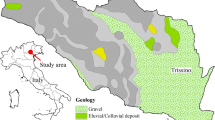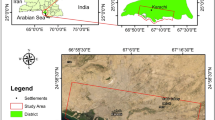Abstract
Land subsidence is a widespread phenomenon, particularly relevant to natural areas such as wetlands, deltas, and lagoons characterized by low elevation with respect to the mean sea level. The possibility of mapping vertical displacements of large coastal lowlying areas at very high resolution began in the 2000s with the development of the Persistent Scatterer Interferometry (PSI). This synthetic aperture radar (SAR)-based methodology detects the displacements of man-made structures within the landscape, such as buildings, utility poles, and roadways. Experience with SAR data of the European Remote Sensing satellites ERS-1, ERS-2, and ENVISAT, characterized by a spatial resolution of about 20 m, a wavelength λ of the signal of 5.66 cm (C-band), and a repeat cycle of 35 days, suggested that persistent targets can be identified only for a fraction of the number of buildings or infrastructures larger than a few meters, and the precise position of the SAR scatterers are difficult to discern. With a very-high image resolution (about 3 m) and an acquisition repeatability never available in the past (between 11 and 16 days), the new generation of X-band (λ = 3.11 cm) SAR satellites has improved significantly the possibility of monitoring the movements of single small structures scattered within rural and natural environments. In this work, we present the PSI outcome in the Venice Lagoon using the German TerraSAR-X and the Italian COSMO-SkyMed satellites. The investigated period covers the time interval 2008–2011. The outcomes of the two X-band analyses are compared both at the regional and the local scale in terms of target coverage and distribution and subsidence rates.
Access provided by Autonomous University of Puebla. Download conference paper PDF
Similar content being viewed by others
Keywords
1 Introduction
Over the last century, eustacy and land subsidence have produced a relative sea level rise (RSLR) on the Venice coastland ranging from centimetres to meters (Carbognin et al 2010). RSLR seriously increased the vulnerability and the geological hazard (e.g., river flooding, riverbank stability, seawater intrusion, coastline regression) of low-lying environments such as deltas, lagoons, wetlands, and farmlands, a large portion of which lies 3–4 m below the mean sea level. Land subsidence due to natural and anthropogenic activities is the main component of the RSLR in the Venice coastland, and therefore it has been monitored since the end of the 19th century. Over the last decade Persistent Scatterer Interferometry (PSI) has been effectively used to detect land displacements in the Venice region. In particular ERS1/2 and ENVISAT ASAR provided an excellent subsidence monitoring “network” suitable both for scientific and coastal management purposes over a 20-year acquisition period (Teatini et al. 2012; Tosi et al. 2010).
Recently, the development of new very-high resolution X-band radar satellites, such as TerraSAR-X and COSMO-SkyMed, has increased the applicability of PSI to monitor movements of single structures with millimetric precision and metric spatial resolution (Strozzi et al. 2009). In this work we compare the results of a ground movement analysis at the Venice Lagoon and the Po River Delta obtained by PSI on X-band radar images.
2 Materials and Methods
IPTA—Interferometric Point Targer Analysis (Wegmüller et al. 2004), a specific PSI processing chain, was applied on:
-
a stack of 31 COSMO-SkyMed stripmap images acquired between September, 2008 and July, 2011 with a revisiting time usually equal to 16 days but sometimes much larger (up to 144 days from February 23, 2011, and 3 July 17, 2011). HH polarization scenes are characterized by a perpendicular baseline ranging from −719 to 695 m with respect to the central reference image of January 19, 2010, a bandwidth equal to 100 MHz and Doppler values from 600 to 800 Hz. The images are characterized by a 35º incidence angle;
-
a stack of 30 TerraSAR-X stripmap images acquired between March, 2008 and January, 2009 with a regular 11-day revisiting time. HH polarization images are characterized by perpendicular baseline values between −148 and 190 m with respect to the central reference image of June 15, 2008, and by a 150 MHz bandwidth with good overlap of common reflectivity spectra. The images are characterized by a 28º incidence angle.
IPTA combines data from SAR images acquired from repeat track orbits to exploit the phase differences of the radar signals that are related only to surface displacement occurring between the image acquisitions. The contribution of surface topography to the interferometric phase is systematically removed and the variability in the tropospheric path delay mitigated by utilizing differences in the spatial and temporal characteristics of the phase due to deformation and atmosphere. IPTA-derived deformation measurements are interpreted for a number of point radar-bright and radar-phase-stable targets (PTs) that are coherent over the entire time interval and cover the monitored area as a sparse “natural” benchmark net.
IPTA results have been calibrated using permanent GPS stations to correct the so-called flattening problem (Teatini et al. 2012), i.e. the slight phase tilt resulting by the inaccuracy in estimation of the orbital baseline due to the not perfect knowledge of the satellite position.
3 Results
An image of the average land displacement obtained at regional scale by processing the COSMO-SkyMed and the TerraSAR-X scenes is shown in Fig. 33.1.
Mean displacement rates of the Venice coastland obtained by PSI on (a) COSMO-SkyMed scenes from September 2008 to July 2011 and (b) TerraSAR-X scenes from March 2008 to January 2009. The red boxes in (b) represent the areas shown in Figs. 33.2 and 33.3. Movements are in the satellite line-of-sight direction. Negative values indicate settlement, positive uplift
Note the larger frame of the available COSMO-SkyMed scenes with respect to TerraSAR-X, this letter covering the Venice Lagoon only.
The figure shows displacements ranging from −50 mm/yr of subsidence to a few mm uplift. In general the higher sinking rates are detected in the nearby of the inlets of the Venice Lagoon because of the soil consolidation induced by the MOSE works and in the embankments bounding the inner waterbodies in the Po Delta. Stable areas, i.e. with displacement of a few millimeters per year, are the historical center of Venice, its mainland, and the ancient sandy beach ridges well developed along the inner sector of the Po delta. The regional subsidence generally increases moving southward toward the Po Delta.
Interesting results are obtained at the local scale. As an example, we show the comparison between the displacements obtained using COSMO-SkyMed and TerraSAR-X images on the coastal structures under construction and reinforcement at the Lido inlet (Fig. 33.2). COSMO-SkyMed and TerraSAR-X produce similar outcomes on the littoral strip of Punta Sabbioni and provide a significant pattern of the displacement rates of the coastal structures. The spatial variability of the movements is related to the different consolidation degree of the coastal deposits below the constructions. A lowering on the order of 20–40 mm/yr is detected both by TerraSAR-X and COSMO-SkyMed all along the north structure with the exception of the 10-m deep dock excavated in the central part where TerraSAR-X points out a rising by almost 10 mm/year. This temporary upheaval is caused by the squeezing of the fine-grained subsoil forced by the load of the surrounding structures and the hydraulic overpressure acting on the lock bottom located at about 10 m below the mean sea. The southern jetty shows a substantial stability in the offshore portion and displacement rates down to −70 and −30 mm/yr with TerraSAR-X and COSMO-SkyMed, respectively, toward the root of the structure due to its recent reshape. The smaller displacement rates detected by COSMO-SkyMed is due to the longer period spanned by these images that account for the ongoing consolidation process.
Mean displacement rates at the Lido inlet of the Venice Lagoon obtained by PSI on (a) COSMO-SkyMed scenes and (b) TerraSAR-X scenes. The location of the area is provided in Fig. 33.1b. Movements are in the satellite line-of-sight direction. Negative values indicate settlement, positive mean uplift
A comparison of the suitability of COSMO-SkyMed and TerraSAR-X to monitor land subsidence in the natural lagoon environment is shown in Fig. 33.3. The area is located on the northern portion of the lagoon. Both the satellites are able to provide information along the embankments bounding Valle Liona and Valle Grassabò on the eastern side. However, TerraSAR-X detects much more measurable PTs at Valle Cavallino, St. Cristina Island and the marshes bounding the Valle di Ca’ Zane westward. This higher capability is likely due to the more regular distribution of the scenes and the shorter period spanned by TerraSAR-X.
Mean displacement rates on the northern portion of the Venice Lagoon obtained by PSI on (above) COSMO-SkyMed scenes and (below) TerraSAR-X scenes. The location of the area is provided in Fig. 33.1b. Movements are in the satellite line-of-sight direction. Negative values indicate settlement, positive mean uplift
4 Conclusive Remarks
In conclusion the use of X-band radar images to detect ground displacements by SAR interferometry allows the measurement of ground movements with millimetric precision and metric spatial resolution. The comparison between the results obtained by IPTA using COSMO-SkyMed and TerraSAR-X acquisitions shows that both satellite missions provide excellent data for detecting settlements and assessing accommodation of engineering coastal structures at high resolution. However, the shorter revisiting time and more regular acquisition properties of TerraSAR-X allow IPTA to detect coherent reflectors also in natural environments such as the inner Venice Lagoon.
References
Carbognin L, Teatini P, Tomasin A, Tosi L (2010) Global change and relative sea level rise at Venice: what impact in term of flooding. Clim Dyn 35(6):1055–1063
Strozzi T, Teatini P, Tosi L (2009) TerraSAR-X reveals the impact of the mobile barrier works on the Venice coastal stability. Remote Sens Environ 113:2682–2688
Teatini P, Tosi L, Strozzi T, Carbognin L, Cecconi G, Rosselli R, Libardo S (2012) Resolving land subsidence within the Venice Lagoon by persistent scatterer SAR interferometry. Phys Chem Earth 40–41:72–79
Tosi L, Teatini P, Strozzi T, Carbognin L, Brancolini G, Rizzetto F (2010) Ground surface dynamics in the northern Adriatic coastland over the last two decade. Rendiconti Lincei 21(SUPPL. 1):115–129
Wegmüller U, Werner C, Strozzi T, Wiesmann A (2004) Multitemporal interferometric point target analysis. In: Smits P, Bruzzone L (eds) Analysis of multi-temporal remote sensing images, vol 3. World Sci, Hackensack, pp 136–144
Acknowledgments
Data courtesy: (1) COSMO-SkyMed AO, Project ID 2100 © ASI “Land movements in the Venice Lagoon: measuring the natural/regional and anthropogenic/local components by SAR Interferometric Point Target Analysis (IPTA); (2) TerraSAR-X, Project COA0612 © DLR “Assessing vertical movements of natural tidal landforms and anthropogenic structures at the Venice Lagoon inlets”.
Author information
Authors and Affiliations
Corresponding author
Editor information
Editors and Affiliations
Rights and permissions
Copyright information
© 2014 Springer International Publishing Switzerland
About this paper
Cite this paper
Teatini, P., Tosi, L., Strozzi, T. (2014). Capability of X-Band Persistent Scatterer Interferometry to Monitor Land Subsidence in the Venice Lagoon. In: Lollino, G., Manconi, A., Locat, J., Huang, Y., Canals Artigas, M. (eds) Engineering Geology for Society and Territory – Volume 4. Springer, Cham. https://doi.org/10.1007/978-3-319-08660-6_33
Download citation
DOI: https://doi.org/10.1007/978-3-319-08660-6_33
Publisher Name: Springer, Cham
Print ISBN: 978-3-319-08659-0
Online ISBN: 978-3-319-08660-6
eBook Packages: Earth and Environmental ScienceEarth and Environmental Science (R0)







